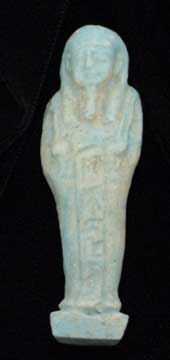 |
Blue Faience Shabti about 700 B.C |
Special Collections Homepage McKay Gallery Homepage David O. McKay Library Homepage |
 |
Blue Faience ShabtiAlso called ushabti or shawabti, the purpose of this shabti was to spare its owner from menial labor in the afterlife. It was buried with a body with the intent that it would come forth when called upon to perform labor on behalf of the deceased. This shabti was produced during the Late Period of ancient Egypt, circa 747-332 B.C. Thousands of these faience shabtis were produced during this period.The shabti is about 4 1/2 inches tall and is molded of faience paste. Faience is a man-made compound with a clay-like body that contains ground quartz, lime, and natron or plant ash. When fired, faience becomes vitreous, and develops a "self-glazed" finish with a blue or green colour. This clay-like material was used to create beads, jewelry, vessels for precious oils and perfumes, and figurines. |
| Treasures from the Archives Homepage |